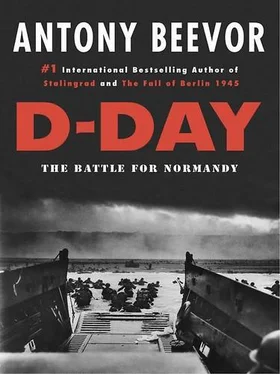It is important to remember that a number of those who opposed Hitler on military grounds did not necessarily object to the ‘final solution’, except in certain details. Eberbach was recorded on tape to have said to his son in captivity in England that September, ‘In my opinion, one can even go as far as to say that the killing of those million Jews, or however many it was, was necessary in the interests of our people. But to kill the women and children wasn’t necessary. That is going too far.’ His son, a naval officer, replied, ‘Well, if you are going to kill off the Jews, then kill the women and children too, or the children at least. There is no need to do it publicly, but what good does it do me to kill off the old people?’
When Churchill met Roosevelt in Quebec for the Octagon conference that September, Field Marshal Brooke wrote a brief ‘Explanation of Continued German Resistance’: ‘Continued German Resistance is chiefly due to the fanatical determination of Nazi Party leaders to fight to the end and to their possession of the necessary political and psychological control in Germany. This determination is based on the doctrine held by the Nazis that Germany surrendered too quickly in 1918; their fear for their own safety; a fanatical belief in their own capabilities which prevents them from accurately appraising the situation; and the lack of any alternative to continued resistance which would seem to offer opportunities for a later revival of their power.’
Some Soviet Hiwi volunteers with the German forces proved fanatically loyal. A member of the 272nd Infantry Division wrote that they ‘had a really good relationship with them’. They also proved extremely effective at looting food for their German comrades. And ‘Panzer’ Meyer of the 12th SS Division had a cossack orderly who seems to have been devoted to him.
Altogether 130,000 men were drafted into the Wehrmacht and Waffen-SS from Alsace, Lorraine and areas of southern Belgium. They were classified as ‘Volksdeutsche’, but reluctant Francophones described themselves as ‘ malgré-nous ’, or ‘despite ourselves’.
The US Army carried out a careful examination of their German prisoners. A report recorded that their average age was twenty-eight, their average height was 5 foot 5¾ inches, and that their average weight was just under 150 pounds. The shortest were those born between 1919 and 1921, the ‘starvation years’ in Germany.
A lateral bomb run would mean approaching the narrowest side of the target area. This required them to attack in a very restricted formation. It also exposed their aircraft to flak along the length of the German front.
Stalin’s government was extremely sensitive on this issue. The Soviet ambassador in Washington, DC, made an official complaint after stories about former Red Army soldiers fighting for the Germans were filed by Associated Press and United Press correspondents in Normandy.
Three days later, on 28 July, the Germans became aware from some captured documents that the Third US Army had already moved to France, but the staff running Plan Fortitude had prepared for such a detail leaking out. Through their agents, they had topped up the dummy invasion force with a new Army Group headquarters and the so-called ‘Fourteenth US Army’.
Patton and even Bradley became convinced that the Germans had transferred two panzer divisions before Cobra started. German sources show that this is not the case.
Montgomery’s personal liaison officer with the First US Army observed later that ‘the drawing off of German panzers and the launch of Cobra put an end to the attempts, mainly by Tedder, to get Churchill and Ike to replace Monty’.
The identity of this officer is not certain. It might have been Generalleutnant Dietrich Kraiss, the commander of the 352nd Infanterie-Division, although his death is recorded several days later on 2 August.
Hitler, who had approved his appointment, was unaware that Gersdorff had been ready to kill him with a suicide bomb on 21 March 1943 in Berlin.
Ramcke systematically destroyed the city later by fire and with explosives. ‘It was entirely wiped out!’ he boasted to General von Choltitz later in British captivity. He claimed that he was following the example of Admiral Nelson burning Toulon in 1793.
The sole hint that the Germans might be planning something came on 2 August through Ultra. The signal said only that 2nd Panzer-Division had carried out ‘withdrawal movements’ on the fiercely contested sector south of Vire and the 1st SS Panzer-Division’s position was unchanged.
Observers from the 12th SS Panzer-Division Hitler Jugend and the medical officer of the 101st SS Heavy Panzer Battalion were convinced that five Tigers had been knocked out. The other two may well have been knocked out by the 144th Regiment Royal Armoured Corps.
The Luftwaffe III Flak Corps was commanded by Generalleutnant Wolfgang Pickert, who in November 1942 had pulled his 9th Flak Division at Stalingrad out during the Soviet encirclement of Paulus’s Sixth Army.
The unfortunate commander of the 708th Infanterie-Division, Generalmajor Edgar Arndt, was later taken prisoner by an FFI detachment commanded by Colonel ‘Montcalm’. He was executed with two other officers on 25 August, the day of the Liberation of Paris, in reprisal for a massacre in Buchères carried out by the 51st SS Panzergrenadier-Brigade. They had shot sixty-six civilians, mostly women and children, and burned down forty-five houses.
Within a few days, the 2ème DB set up a recruiting centre in a barn near Sées to process those volunteers who lacked military training. Two weeks later, most of them were sent on by truck to Saint-Germain-en-Laye and billeted in the barracks formerly used by the guard for Generalfeldmarschall von Rundstedt’s headquarters.
Fewer than 2,000 German soldiers died at the hands of the Resistance before the retreat of August 1944. Figures during the retreat have proved impossible to establish. Yet up to the Liberation, the Germans and the Vichy Milice killed some 20,000 people. Another 61,000 were deported to concentration camps in Germany, of whom only 40 per cent returned alive. In addition, 76,000 French and foreign Jews were deported east to concentration camps. Very few returned.
That autumn, both Pierre Laval and Marshal Pétain, the latter under protest, would be taken back to Germany to the castle of Sigmaringen. In 1945, both would be tried in France, Laval receiving a death sentence and Pétain life imprisonment.
When Arletty, the great actress and star of Les enfants du Paradis , died in 1992, she received admiring obituaries. These tended to pass over her controversial love affair conducted largely in the Hôtel Ritz with a Luftwaffe officer (who subsequently became a West German diplomat and was eaten by a crocodile when swimming in the River Congo). But then letters to some newspapers revealed a lingering bitterness nearly fifty years later. It was not the fact of her sleeping with the enemy that had angered them, but the way she had eaten well in the Ritz while the rest of France was hungry.
Читать дальше











